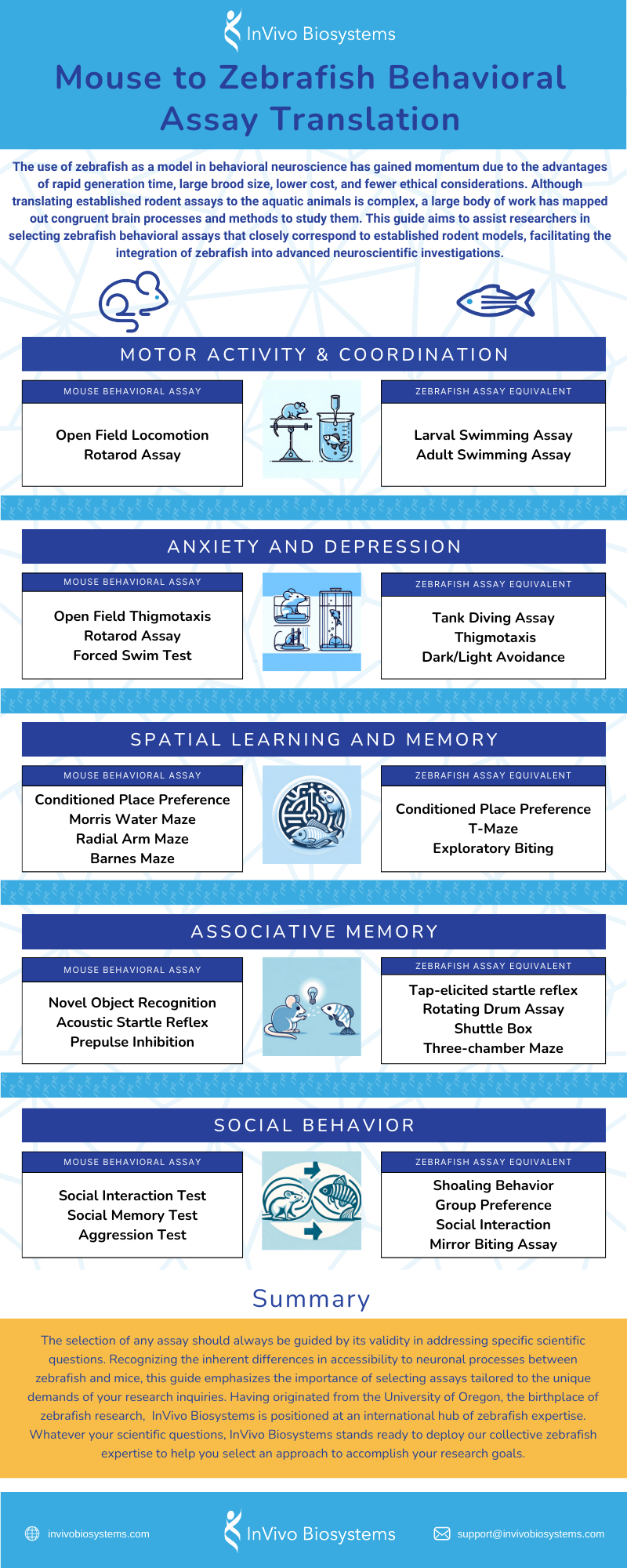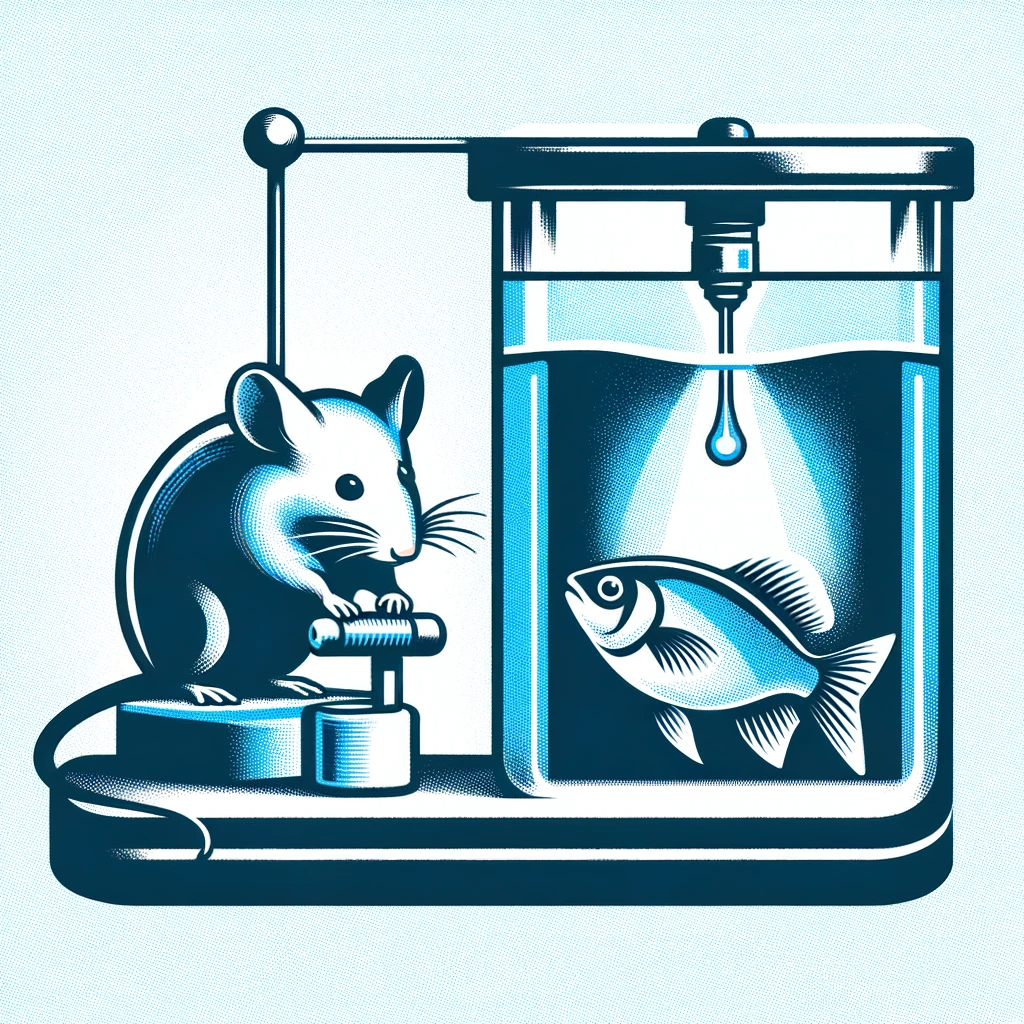The Rise of Zebrafish Research
In the realm of neuroscience, behavioral studies using animal models are essential for understanding brain functions and developing treatments for neurodegenerative diseases. Traditionally, rodents such as mice have dominated this space, being central to numerous behavioral studies and genetic research due to their well-characterized neurological pathways and the extensive mouse model databases available. However, the zebrafish (Danio rerio) has emerged as a formidable alternative, offering unique advantages that complement and, in some cases, surpass those offered by mouse models.
The genetic similarity of zebrafish share with humans, as well as their transparent embryos, makes them an excellent choice for in vivo imaging and genetic manipulation studies, particularly in the field of developmental biology and neurobehavioral genetics. The rapid development and transparent zebrafish embryos offer unique advantages for embryonic development studies, making zebrafish a compelling model for in vivo development embryonic phenotype analysis. The affordability of housing zebrafish, along with their short generation time, large brood size, lower cost, and fewer regulatory constraints under institutional animal care, makes them an economical and expedient model for studying both behavioral and neural processes.
This shift in preference highlights the ongoing debate in the scientific community about zebrafish vs. mouse models, examining the efficacy and applicability of each in neuroscience research, particularly in the study of clinical phenotypes and behavioral responses. Zebrafish, although a relatively new player in the fields of genetics and neuroscience have seen an exponential increase in their use for behavioral assays over recent decades. The translation of animal behavior from terrestrial to aquatic environments is complex, yet ongoing research is steadily mapping out congruent brain processes and methods to study them.
For some applications, the zebrafish has even emerged as the preferred model. This progress positions zebrafish as an increasingly valuable asset in both basic and translational neuroscience research, especially when considering genetic background and immune response in the context of patients with mutations. This guide aims to assist researchers in selecting zebrafish behavioral assays that closely correspond to established rodent models, thereby enhancing the integration of zebrafish into advanced neuroscientific investigations.
Comparing Mouse to Zebrafish Models for Behavioral Discovery

Motor Activity and Coordination
Larval Locomotion Assay1 – Compatible with automated platforms and high throughput compound screening with multiple parameters of locomotion indexed, showcasing a behavioral phenotype that aligns with function mutation studies.
Adult Locomotion Assay1 – With automated tracking, provides rich phenotypic data at higher throughput and shorter timelines than rodents, aiding in the exploration of neurological phenotypes and pathogen exposure effects.
Anxiety and Depression
- Tank Diving Assay 2,3– Zebrafish, like many other fish species, dive defensively in response to a threat. When zebrafish are introduced to an unfamiliar tank, they tend to dive to the bottom and gradually rise to upper levels over several minutes. This behavior is well characterized in zebrafish and automated approaches have been developed for quantification, serving as experimental evidence for the study of autoimmune response.
- Thigmotaxis 4– This term commonly refers to the tendency of rodents to cling to the outer walls of an enclosure in an open field test. Fish likewise will spend more time swimming near the walls of an unfamiliar tank or well in a microplate, particularly when under stress. 3,5 This is one of multiple behaviors that lend themselves to high throughput measurement in a microplate format.1
Spatial Learning and Memory
Conditioned Place Preference
3,6– Analogous to the rodent assay of the same name, fish are placed in a tank with two or more rooms containing different rewards or punishments, highlighting the functional role of neuronal activity in associative memory.T-Maze or Plus Maze
7– Also directly analogous to the rodent version. A fish is presented with a choice of two or more differing paths to address questions of learning and cognition as well as navigation.Exploratory Biting
8– Fish instinctively bite a new object placed in their habitat to learn about what it is. The biting ceases as they gain familiarity with the object. Similar to Novel Object Recognition in which rodents spend more time with new objects than familiar ones in their habitats.
Associative memory
Place preference and T-maze assays (described above)
Tap-Elicited Startle Reflex
9– Uses larval escape reflex as a high-throughput readout for neuronal function.Rotating Drum Assay
10,11– A fish will hide behind a central cylinder in response to a threat-a vertical band on a rotating drum-rotating around its habitat. Also assays the effects of any treatments on vision.Three-chamber Maze
12– Variation on T-maze to assess non-spatial learning.Shuttle Box
13– Rapid associative learning assay used to study cognitive impairment.
Social Behavior
Shoaling behavior
14,15– Tests the behavior of a group of fish or a single fish within a conspecific (same species/strain) group.6), illustrating natural fish behaviors and providing insights into the social interaction test dynamics.Social Group Preference
3,16,17– Scores activity of a fish separated from two distinct groups.Social Interaction Test
3,16– fish presented with a conspecific partner separated by a barrierMirror biting test
16– Tests aggression through presentation of a conspecific challenger.
Summary
Navigating the complexities of neuroscience demands a nuanced approach, where the selection of assays should always be guided by their validity in addressing specific questions. Think of our guide not as a definitive map but as a reliable compass, offering a strategic starting point for choosing the most appropriate experimental strategy. Recognizing the inherent differences in accessibility to neuronal processes between zebrafish and mice, our guide emphasizes the importance of selecting assays tailored to the unique demands of your research inquiries, including considerations for animal facilities and the use of 24-well plates in behavioral experiments.
InVivo Biosystems: Your Research Parter
InVivo Biosystems, a company that originated from the University of Oregon – the birthplace of zebrafish research under George Streisinger18 – is situated at a hub of zebrafish expertise. This includes collaboration with multiple institutes at the University of Oregon and the Zebrafish International Resource Center (ZIRC). Leveraging this unique pool of knowledge, InVivo Biosystems has compiled this guide. Whatever your scientific questions may be, our collective zebrafish expertise is ready to be deployed to help you navigate the complexities of model organism selection. Trust InVivo Biosystems to assist you in selecting an approach that not only meets but exceeds your research goals.
More About Zebrafish as a Model Organism
Interested in learning more about utilizing Zebrafish as a model organism in your research? We have more material linked below for you to explore:
Zebrafish Resource Center – InVivo Biosystems
Zebrafish 101: A White Paper – InVivo Biosystems
Behavior & Morphology Analysis – InVivo Biosystems
As a Researcher, Why Choose Zebrafish? – InVivo Biosystems
As a Researcher, Why Choose Zebrafish? Unique Models: Organ Regeneration – InVivo Biosystems
Better Together? Zebrafish and Mice Models should be utilized in Conjunction. – InVivo Biosystems
Comprehensive Zebrafish CRO Services | InVivo Biosystems
Zebrafish Genome-Editing Services | InVivo Biosystems
Review Of Zebrafish Models To Boost Research In Rare Genetic Diseases – InVivo Biosystems



